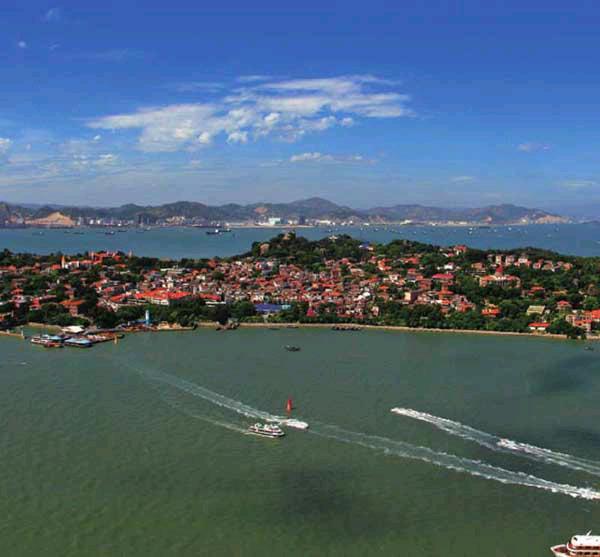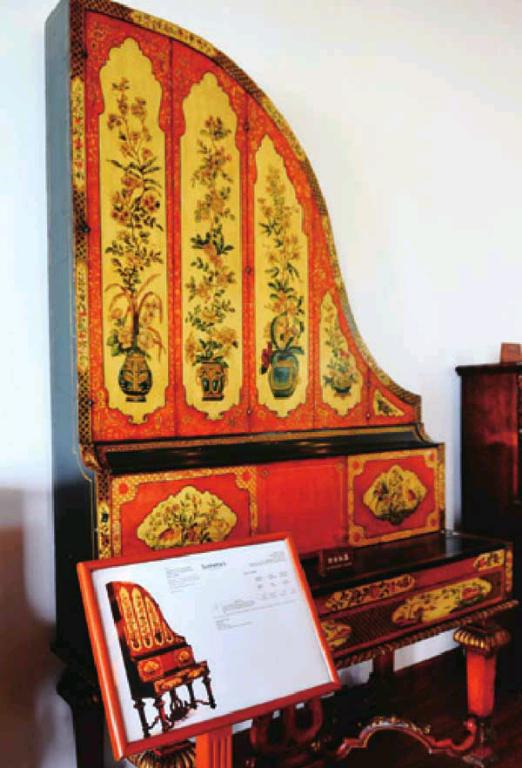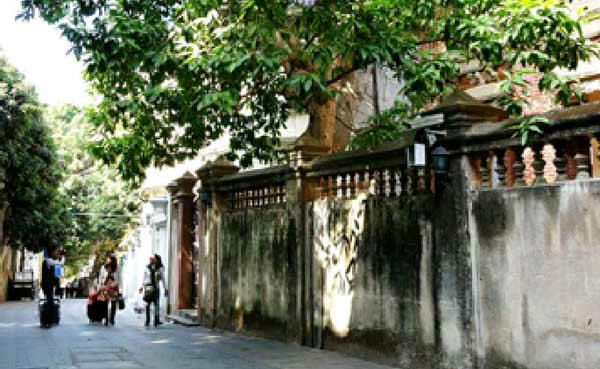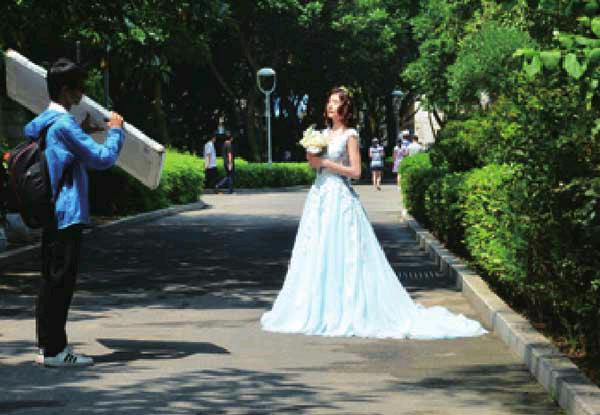ISLAND OF MAGIC
2016-08-17BySudeshnaSarkar&
By+Sudeshna+Sarkar+&+Chen+Ran
If it pours in Xiamen, a historical port city in southeast Chinas Fujian Province where the weather is subtropical with showers year-round, then on Kulangsu, the magical island a 10-minute ferry ride from the city, it pours brides.
There are brides everywhere—kneeling theatrically in the middle of the road, draped against sun-baked, moss-covered old walls, frolicking on the beach. Brides young, beautiful and dressed in frothy white wedding gowns with wispy bouquets of silk flowers in their hands.
They are trailed by a small cohort of men carrying umbrellas, tripods, cameras and even makeup kits. Are they real, or is it an elaborate film shoot?
A bit of both, since Kulangsu climbs up the charts as a favorite domestic destination for prewedding photographs, an obligatory ritual for Chinese couples who have plighted their troth.
Liang Zhao and Li Sainan are such a couple. Liang, a 26-year-old with a small business, and Li, also 26 and a nurse, have come to Kulangsu all the way from Shanxi Province in the north to have their wedding album put together by a professional photography agency before they tie the knot on September 9.
“Being in the north, my wife and I seldom get to see the sea,” Liang said, explaining the decision to choose Kulangsu. “Its such a beautiful place with such amazing history and culture.”
The island, with a population of about 20,000, is a magnet to nearly 65,000 visitors daily, according to Shen Huan, a representative of the Public Relations Department of the Kulangsu Tourist Center. During the peak season—which starts from the national holiday in October and continues till November—their number can surpass 120,000.
“Last year, we had 13 million visitors,” Shen said. “The money generated from ticket sales [to the scenic spots and museums] alone was nearly 150 million yuan ($22.5 million). Kulangsu is the most popular destination after the Palace Museum in Beijing.”
Steeped in history
What makes a tiny island of less than 2 square km a tourist paradise? Its not just the lush gardens, picture-perfect beaches, granite hills and sentinel rocks offering dazzling views of the surroundings. Its the ambience, the result of being steeped in unique history and a potpourri of cultures.
Xiamen was one of the first Chinese cities to open up to foreign trade after the First Opium War (1840-42) between China and Britain ended with an unequal treaty imposed on the former. Kulangsu, like Xiamen, subsequently saw an influx of foreigners who came to work or trade, fell in love with the island, and took up residence there.
It is also said to be the first island in China where Christian missionaries set foot and boasts three churches, which are among heritage buildings, a Christian cemetery and the London Missionary Societys billet for its women staff.
The confluence of so many diverse cultures has made Kulangsu known as the “Chinese Mediterranean.” The most visible impact is on the architecture, which is a mix of the domestic and European. Another noticeable influence is the care given to environmental protection. Despite the daily crowds, the little island stays pollution- and traffic-free by banning cars and larger vehicles. Bikes are the preferred mode of transport or electric buggies.
A large number of Kulangsu residents have gone abroad, either forced by circumstances or seeking their fortune. These overseas Chinese continue to have strong ties with their homeland, contributing to its development by building educational institutions, hospitals, museums and other progressive institutions they encountered in their host countries.
The stories of the overseas Chinese and their love for the motherland, painstakingly recorded by the Overseas Chinese Museum in Xiamen, add another sparkling facet to Kulangsus uniqueness.
Hu Youyi is one of them. A Chinese with an international outlook, Hu received an unusual education, learning to play the pipe organ and piano at the Royal Conservatory of Brussels. He later emigrated to Australia and made his fortune through real-estate and stock transactions. Though Hu died in 2013 at the age of 77, his name lives on in Kulangsu, having become an indelible part of the islands cultural legacy.
Piano Island
The bond of music between Kulangsu and Hu seems to be fate. The very name Kulangsu is musical. In the south Fujian local dialect, it melds three characters: ku meaning drumbeat, lang or the tide, and su, which means island. The name comes from the sound made by the tidal waves as they hammer a giant rock on the islands southwestern coast, similar to the gong of drums.
The name is apt because Kulangsu is also called the “Hometown of Music” and “Piano Island,” said Zhu Yan, Curator of the Piano Museum, Kulangsus pride and glory and the brainchild of Hu.
“Music has always been an integral part of the island,” said Zhu, sitting in the sunny,harmonious museum in the middle of a blooming garden and overlooking the sea. “The Chinese Musicians Association has awarded the titles to Kulangsu because of the large number of musicians it has produced. It is also home to more than 600 pianos.”
Zhu traces the piano culture to the 1840s when foreigners and non-locals flocked to the island with their families. Some of them brought pianos and thats how the instrument took root. Lin Erjia, a businessman who owned Shuzhuang Garden, where the Piano Museum is located, brought Kulangsus very first piano in 1913 to decorate his home. The schools run by the churches also brought pianos.
“People come to Kulangsu not just for the scenic beauty but for the music as well,” Zhu said. “We already have two musical instrument museums and are going to build a third one. It will display instruments from neighboring and African countries, and add to the music legacy.”
Visitors itineraries invariably include a trip to the Piano Museum and its companion, the Organ Museum. Together, they house over 200 pianos and organs collected by Hu in nearly four decades. It started as a hobby, inspired by Hus fascination with a musical instrument museum near his music school in Brussels. Realizing their pricelessness as records of music history, he decided to build a similar institution in Kulangsu so that he could share them with more people.
The Piano Museum was inaugurated in 2000 and the Organ Museum five years later. What enhances their charm is the live music they offer visitors along with glimpses of rare, historical and majestic pianos and organs.
At the Organ Museum, for instance, the first riveting exhibit is an immense 6-meterhigh organ more than 100 years old and still functioning. The instrument was made in 1909 by Norman and Beard, a Norwich-based organ manufacturer who opened shop in 1887. It has 1,350 parts and poses a formidable challenge to players with its massive three keyboards.
But 30-year-old Zhang Xiaoqiao, a piano and accordion major from the Shanghai Conservatory of Music and a museum staff member, is unfazed, expertly running her hands down the keys and playing Felix Mendelssohns Wedding March to the awe of visitors.
“Mr. Hu, who had no children, regarded the organs and pianos as his children,” said Wang Xiayi, a guide at the museum. “He thought it was very important for the conservation of culture and he wanted to build the museum in Kulangsu as it is known as the Island of Music. All the instruments at the museum are from his collection and were shipped from Australia.”
The Piano Museum was designed by Hu himself, who meticulously planned where each piano was to be placed. The staff still remembers with fondness the frequent calls he would make from Australia to check if the work was progressing satisfactorily.
Besides opening up the marvelous world of pianos to visitors, the Piano Museum also acquaints them with musical icons abroad including Richard Wagner, Franz Schubert and Johannes Brahms, as well as Chinese maestros such as concert pianists Lang Lang and Fu Cong.
The history of music is inextricably linked with global socio-economic development and the museum shows how a piano is more than a mere instrument. The 1945 Lindner plastic piano, for instance, is a reflection of the bleakness that pervaded the 1940s. Still reeling from the Great Depression triggered in 1929, the world was plunged into World War II a decade later. Though the war ended in May 1945, the global economy was left devastated. It made the Ireland-based piano manufacturer devise pi-anos using mostly plastic components to slash the costs necessary to keep the music playing.
Reaching for recognition
Music and the museums have a major role to play as the Kulangsu authorities wish to have the island recognized by the UN Educational, Scientific and Cultural Organization (UNESCO) as a world cultural heritage site.
“Kulangsus culture goes beyond borders,” said Zhang Shunbin, Deputy Director of the Administration Committee of Kulangsu Wanshishan Scenery District. “Its an amalgamation of local, Southeast Asian and European cultures enhanced by the contributions of the overseas Chinese. It is where the East meets the West.”
Zhang said that the process for gaining UNESCO recognition started in November 2008.“We have already been working to protect our historical architecture and other landmarks. Renovations are going on while new facilities are being added. The inclusion in the world cultural heritage site list will help us manage the island better and enhance conservation,” he said.
The campaign was half won earlier this year when the Chinese Government assessed applications from several local governments and made two nominations to UNESCO: the Hoh Xil Nature Reserve in Qinghai in northwest China and Kulangsu. Now the island is expecting an assessment visit from members of UNESCOs World Heritage Committee. Once the inspection team submits its report, the 41st session of the World Heritage Committee, scheduled for 2017 in Poland, will discuss the merits of new applications and come to a decision.
Deng Huiqiang, Director of the Kulangsu Visitor Center, makes an impassioned case for Kulangsus inclusion. “The islands cultural heritage belongs to all people, not just the Chinese,”he said. “Kulangsus people went abroad and people from abroad came to Kulangsu, creating a fusion of new arts, architecture and ideas. Kulangsu is a very special place. Inclusion on the UNESCO list will let people far away know that there a tiny island exists that has produced so many incredible people and things.”

The homecoming
A striking 19th-century piano at the Piano Museum symbolizes all this and more. It looks like a typically Chinese antique, painted in a warm red with delicate images of the flying egret, a bird indigenous to Kulangsu and Xiamen.
However, the “egret piano” was not made in China but in London by British piano maker Collard and Collard. Hu spotted it at a Sothebys sale in Australia and bought it in 2010 for AU$172,020 (currently $127,264) according to the accompanying bill of sale. The piano is a witness to the growing appreciation of Chinese arts.
Chinoiserie, Europes emulation of the Chinese style in the arts, architecture, literature, music and more, was a trend that started in the 17th century, triggering collectors frenzy for Chinese furniture and porcelain.
After traversing the world, the piano is finally home where it belongs. And so is Hu.
“Mr. Hus last wish before he died was for his ashes be scattered in the sea off Kulangsu,”Deng said, pointing to a stretch of water visible from the room in the museum originally meant to be the founders office. “His wife Huang Yulian brought the ashes and scattered them there in 2013. He lives on through the museum, through the music.”
